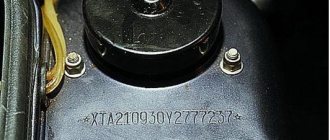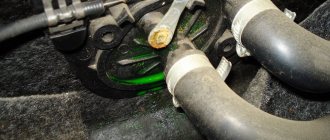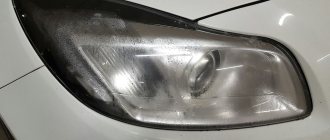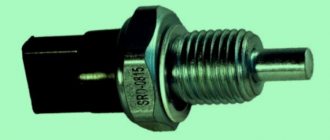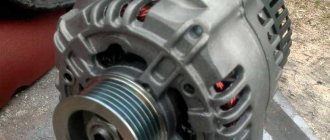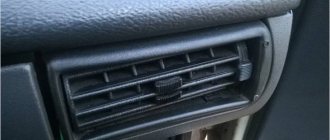Devices for troubleshooting electrical wiring
To find a short circuit or broken wiring, you can use a multimeter.
If you only need to determine the presence or absence of voltage on a section of the circuit, then you can use a special 12 V light indicator. A test lamp that you can make yourself is also suitable. To do this, two wires with a length of at least 50 cm should be soldered to a car lamp (no more than 4 W).
The consumer is not always right
How to determine the capacity of a car battery and extend the service life of the battery
Having already identified a specific circuit and knowing (in accordance with the existing circuit) which consumers are connected to it, you can turn them off one by one and check the line again with a light bulb/multimeter. If they are not the cause, the wires remain. Finding the right one can be difficult without professional help.
The advantage of a short circuit of a specific automobile unit is that if it is not vital (for example, a radio), it will be enough to simply turn it off and move on. But such a malfunction should not be underestimated. After all, if the fuse does not blow, the whole car may burn out. Smoke and fire are the most obvious signs of a short circuit. If this happens, stop immediately and begin searching for a short circuit in the electrical wiring only if you are sure that it is safe.
The main thing is to be careful
How to find a broken wiring in a car
If there is a break, the electrical circuit opens. Often the cause of lack of voltage is poor contact in the circuit connector. The block body hides oxidized contacts, so troubleshooting can take a long time. A break may be detected when the pads or wires are swayed.
To find a break in the test, you need to set the multimeter in ohmmeter or continuity mode. The terminals of the device are connected to the ends of the circuit being tested:
- If there is no break, the multimeter will beep (in dial mode) or the resistance will be minimal (in ohmmeter mode).
- If there is a break in the wiring, there will be no sound signal (in dial-up mode), but the resistance will be very high (in ohmmeter mode).
Testing of high voltage wires
A multimeter in ohmmeter mode can be used to check for high voltage wire (armor wire) problems if the vehicle has an intermittent high voltage (plug) fault. Before starting this procedure, it is recommended to study the instructions. Measurement procedure:
- Turn on the digital MM, then turn the control dial to the resistance position. Resistance is measured in ohms and is designated on the dial by the capital Greek letter omega.
- Connect the red (positive) MM probe to the positive external field of the ignition coil.
- Touch the black (negative) MM probe to the outer negative post of the device to measure the resistance of the primary coil. If the readings differ from those shown in the vehicle manual, the ignition coil must be replaced.
- Connect the black MM probe to the center negative terminal of the ignition coil. This creates resistance for the secondary coil. Again, if the resistance tested is not what is given in the owner's manual, the ignition coil is not working and the integrity of the system is compromised.
How to find a short circuit in a car wiring
A short circuit is an unacceptable connection of part of a circuit to ground or another part of the circuit. Often the cause of a short circuit is severe oxidation of the contacts in the block, or damage to the insulation of the wires. If, after replacing a faulty fuse, it blows again, there is likely a short circuit in the wiring.
To find a short circuit, disconnect the section of electrical wiring being tested from the rest of the vehicle wiring. Set the multimeter to dialing mode. We connect one probe of the device to a section of the circuit, and the other to the body (“ground”).
- If there is no short circuit in a section of the circuit, the device will not emit sound signals.
- If there is a short circuit, the multimeter will beep (the circuit will be closed).
We inspect the entire section of the chain for damage.
Fault diagnosis
The main sign of the occurrence of an interturn short circuit is uneven heating of the housing. This occurs due to the increased current consumption of one (faulty) winding. If overheating occurs in one part of the housing, the engine must be de-energized and diagnostics performed.
It is performed as follows:
- Check the voltage on all windings. It should be the same, i.e. There must be no phase imbalance in the network. After this, the currents in each winding are measured. Measurements are made using current clamps. If the current in one winding differs from the others in a larger direction, then this indicates a malfunction in this winding.
- Using a high-precision ohmmeter, the resistance of the windings is measured. The values must be the same. It is impossible to check for a short circuit with a conventional device. Because with a short circuit of only two turns, the resistance will change slightly.
- A short circuit to the housing is determined using a megger. To do this, one end is connected to the housing, and the second is connected to the windings alternately. In this way, the integrity of the insulation resistance is checked. Ideally, it should be the same on each winding or have minor deviations. It should be taken into account that it changes depending on the temperature of the conductors.
The figure below shows a table showing the dependence of the change in insulation resistance on temperature:
Technological instructions of AVTOVAZ
Below are general methods for checking electrical continuity, checking for shorts using an ohmmeter and a voltmeter.
Electrical continuity check
Loss of electrical circuit integrity can be caused by the following reasons:
- disconnecting the harness block;
- weak connection of the harness block;
- contamination, oxidation, corrosion of contacts;
- deformation of contacts;
- wire damage.
Check the continuity of the circuit in the following sequence:
- Disconnect the earth wire terminal from the battery.
- Visually check that the harness connectors are connected on both sides of the electrical circuit and that the locking latches are latched.
- Disconnect the pads, visually check the contacts for dirt, corrosion, and deformation.
- By pulling the wires next to the block, make sure that the wire and the terminal are tightly pressed together and that the terminal is fixed inside the block.
- Using a probe of a given diameter and length corresponding to the size of the contact in the mating block, make sure that the terminals of the harness blocks provide a reliable connection (the terminals are not recessed in the block, the probe fits tightly into the terminal).
- Using an ohmmeter, measure the resistance of the circuit between the pads. The resistance of a working circuit should be less than 1 ohm. To avoid damage to the terminals, it is allowed to use probes of a given diameter for measurements that correspond to the size of the contacts in the mating blocks.
Checking the circuit for short to ground
Perform the check in the following sequence:
- Disconnect the connectors on both sides of the electrical circuit.
- Connect the probe, one end connected to the “+” of the battery, to the terminal of the circuit being tested. If the probe lights up, it means that the circuit being tested is shorted to ground.
To avoid damage to the terminal, the probe must be connected using a probe of a given diameter that matches the size of the contact in the mating block.
Checking the short circuit to the on-board network
Perform the check in the following sequence:
- Disconnect the connector on one side of the electrical circuit.
- Connect the probe, one end connected to ground, to the terminal of the circuit being tested. If the probe lights up, it means that the circuit being tested is closed to the on-board network.
- Reconnect the disconnected block.
- Disconnect the connector on the other side of the electrical circuit. Perform check 2.
To avoid damage to the terminal, the probe must be connected using a probe of a given diameter that matches the size of the contact in the mating block.
Measuring voltage at wiring harness contacts
Perform the check in the following sequence:
- Disconnect the connector on one side of the electrical circuit.
- Connect the positive cord of the voltmeter to the terminal of the circuit being tested, the negative terminal to the vehicle ground. Record the voltage value.
To avoid damage to the terminal, the positive cord of the voltmeter must have a probe of a given diameter that matches the size of the contact in the mating block.
Let us remind you that it is more convenient to carry out wiring diagnostics when you have the car’s electrical circuit diagrams at hand (for Lada XRAY, Vesta, Largus, Granta, Kalina, Priora, Niva 4×4).
Key words: universal article
+13
Share on social networks:
Found an error? Select it and press Ctrl+Enter..
Working with a multimeter
Voltage check
If some component in your car has failed (as you think), then you need to check for voltage in the circuit. To do this, switch the device to voltmeter mode, and then measure the voltage. To do this, install the positive probe on the positive of the battery, and the second on the terminal from the device. Thus, where the voltage shows, everything is in order, but where there is no reading, then there is a problem in this section of the circuit.
Before checking the wires, make sure that the battery is producing voltage, otherwise you may be looking for the cause in the wires, but the problem is a faulty battery.
Looking for a short circuit
Such a process during a short circuit is complicated at first glance, since it is notable for the fact that there is completely no voltage in the circuit.
What should be done:
First of all, remove the fuse; it is removed from exactly the section of the circuit that will be tested.
Switch the multimeter to a voltmeter.
The probes are connected to the terminals, it is recommended to de-energize all other devices, this is done to prevent failures in other systems.
Move the wire slightly and at this moment look at the readings, if they appear at some point and then disappear again, it means it is shorted.
Once problem areas are identified, they must be replaced. How to change the wiring in a car is a fairly simple question, and you shouldn’t have any difficulties. It is correct to do this together with the contact system, since if you use a piece of another wire and electrical tape, a new breakdown may appear.
Grounding check
Since most cars have a 1-wire power supply circuit, all devices receive “-” through the body. And because of this feature, you need to check the quality of grounding.
During operation, all components develop rust and poor contact, which can cause the system to malfunction. Therefore, the grounding should be checked correctly.
To check the grounding contacts, you need to do the following:
Remove the battery from the compartment in the car, and then connect one of the contacts to ground.
We install the second probe at the grounding center, this is a special point that is available on every car.
Measure and remember the multimeter readings. Then refer to the car manual and check the required parameters, if they are within acceptable limits, then everything is fine.
As we have already understood, the wires in a car perform many important functions, so their condition must be monitored. Because despite its reliable insulation, due to different climate conditions it can lose its protective qualities. Now you know how to change the wiring in a car, and you can fix the problem yourself if it is discovered. We wish you success so that your car is always on the move and never breaks down!
To repair home electrical wiring or a car's on-board network, you always need to know how to test wires with a multimeter. This device tests the integrity and serviceability of the cable; it can be used to check the insulation resistance and current voltage in the home electrical network. This is an indispensable meter for wiring and practical implementation of electrical projects.
Replacing car wiring
When replacing wiring in a car, be sure to turn off the power, including disconnecting the battery. Of course, this is not a precaution against electric shock, but protection of the vehicle’s electrical equipment from possible short circuits that may occur during repair work.
Sometimes the replacement can be completed in 10-15 minutes - for example, if the wires of the “battery-generator” supply circuit are damaged. If the integrity of the wiring in the cabin is damaged, there are problems with grounding, or a short circuit in the on-board computer circuit, then the work will take much more time. And the main thing here is not to make a mistake, since incorrectly connecting the wires (for example, if the polarity is reversed) can cause a short circuit, damage to expensive electrical equipment and even a fire. If you do not have experience in electrical engineering and electrical installation work, it is better to contact a specialized service for the services of a professional auto electrician.
Source



